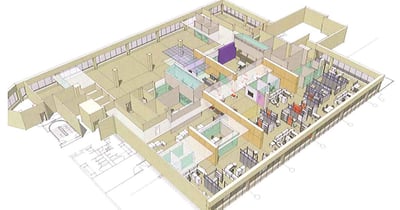
(At Wolgast's request, CPA, Andrew Rose of Rehmann's Commercial Industry Group, generously shared the following expert insight into Cost Segregation to help guide our clients to find tax savings in their building.)
As the economy rebounds, businesses are becoming more profitable. At the same time, higher individual taxes are placing a financial burden on business owners. If you’re looking for ways to reduce taxes and boost cash flow, consider a cost segregation study.
You may benefit from such a study if you plan to acquire, construct, or substantially improve a building, or if you’ve done so in recent years. These studies apply tax accounting and engineering principles to identify building components that qualify for accelerated depreciation. Armed with a cost segregation study, you may be able to cut taxes by claiming additional depreciation expense or capturing missed depreciation deductions from previous years.
An overview
Here’s how it works: commercial real property (excluding land) is depreciated over 39 years (27.5 years for residential rental real estate). Real property includes buildings as well as structural components, such as walls, windows, floors, ceilings, elevators, wiring, plumbing, and HVAC systems. Personal property – such as furniture, fixtures, computers, equipment, and machinery — is usually depreciable over five or seven years. Land improvements – such as parking lots, fences, sidewalks, landscaping, and outdoor lighting – are depreciable over 15 years.
It’s not unusual for owners to allocate costs to real property that could properly have been allocated to shorter-lived personal property or land improvements and depreciated more quickly. A cost segregation study reveals opportunities to reallocate these costs, accelerating depreciation deductions and reducing taxes.
Virtually any business can benefit, but cost segregation studies are particularly valuable for manufacturers, hospitals, hotels, restaurants and other businesses with specialized buildings. Often, property that would otherwise be considered a structural component depreciable over 39 years may be classified as personal property if it’s more closely related to a process or a particular piece of equipment than to the building itself.
A manufacturing facility, for example, might require reinforced flooring to support heavy equipment. Or a hospital may need special wiring or electrical systems to operate medical equipment safely. In many cases, the costs of these items are depreciable over five or seven years.
What are the benefits?
The actual benefits depend on the particular facts and circumstances, but for acquired, constructed or renovated buildings, a rough rule of thumb says you can enjoy net-present-value tax savings as high as 23 cents for each dollar that’s reclassified as personal property. If reclassified property qualifies for 50-percent “bonus depreciation,” the savings can be even greater.
You can also use a cost segregation study to reallocate the costs of real estate investments in previous years. Generally, this requires you to file Form 3115 – Application for Change in Accounting Method – with the IRS. This allows you to take a “catch-up deduction” in the current year for assets that were under-depreciated in prior years.
Evaluate your options
Cost segregation studies can yield significant rewards, but they’re not for everyone. The tax savings may be limited, for example, if your income is insufficient, you’re subject to passive loss limitations, or a property’s purchase agreement contains a purchase price allocation. If you think a cost segregation study would help your business, have your advisors perform an initial evaluation to get an idea of the potential benefits.
Bonus Content: Cost segregation example
Cost segregation studies offer significant tax savings, especially for businesses, such as manufacturers, with specialized facilities. Consider this example:
Wolverine Widgets, a heavy manufacturing company, acquires an existing plant for $10 million on July 1, 2013. If the company were to allocate the entire purchase price to the building, its depreciation deductions would be roughly $256,000 per year ($177,000 in year 1, under IRS tables). Wolverine obtains a cost segregation study, which concludes that 35 percent of the purchase price is properly allocable to 39-year property, 15 percent to 15-year property, 45 percent to seven-year property, and five percent to five-year property.
Based on IRS tables, and using the Wolverine’s first-year depreciation deductions are as follows:
|
Asset class |
Cost |
1st year depreciation |
|
39 years |
$3,500,000 |
$61,950 |
|
15 years |
$1,500,000 |
$75,000 |
|
7 years |
$4,500,000 |
$643,050 |
|
5 years |
$500,000 |
$100,000 |
|
Total |
$10,000,000 |
$880,000 |
In this example, a cost segregation study generated an additional $703,000 in depreciation deductions in the first year alone.
If you would like to get in direct contact with the author, Andrew Rose, CPA and Principal at Rehmann, he can be reached at Andrew.Rose@rehmann.com, or (517) 316-2414.
Also read: How to Make Owning Your Medical Office More Lucrative
